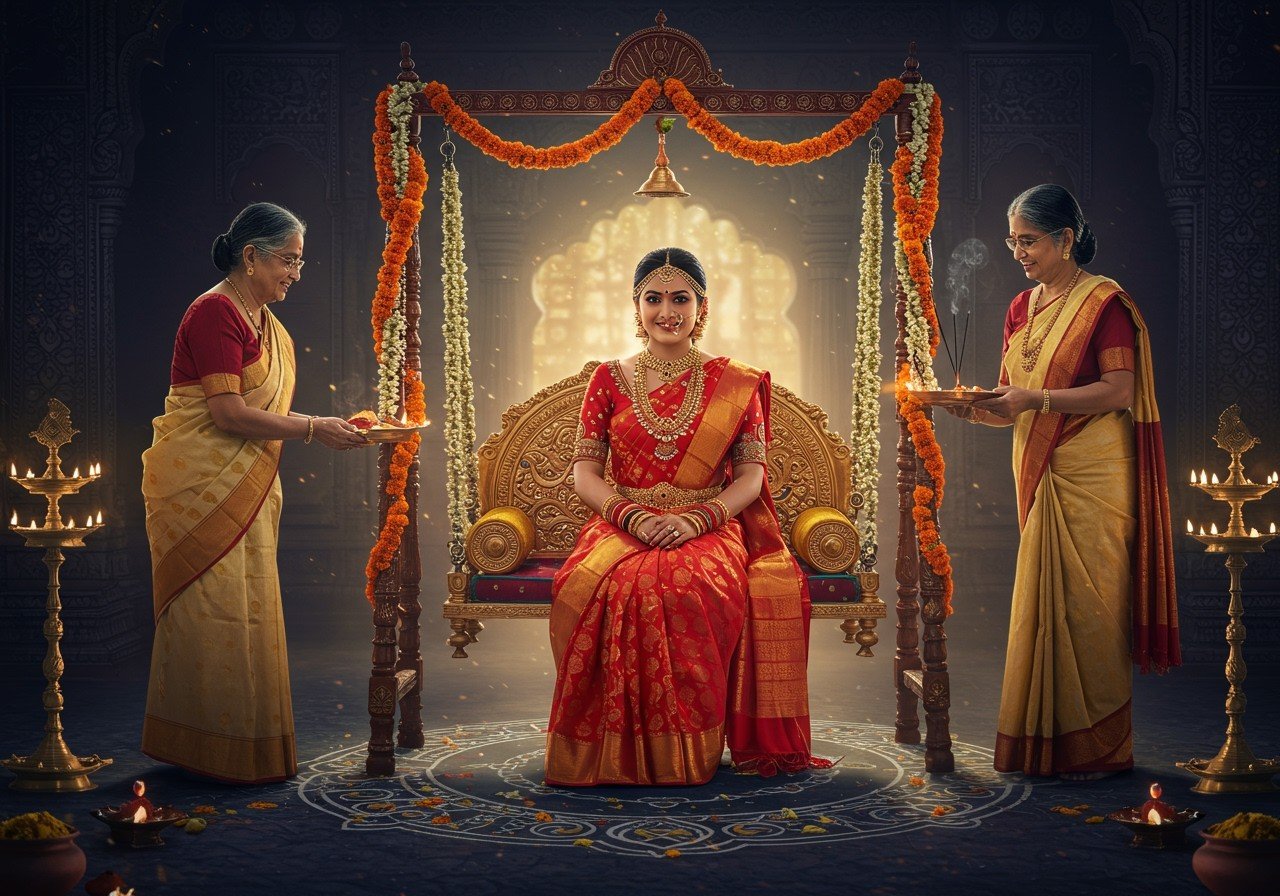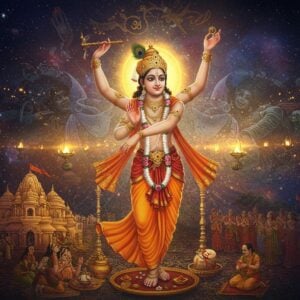
Tamil weddings are a vibrant tapestry of customs, steeped in rich cultural significance and deep-rooted Hindu traditions. These celebrations, while varying slightly among different Tamil communities, are a beautiful blend of age-old rituals and joyous festivities. Let’s explore some of the common traditions that make Tamil weddings so special.
Pre-Wedding Rituals: Setting the Stage for a Blessed Union
The journey to marital bliss begins with a series of pre-wedding rituals, each carrying its own unique meaning:
- Lagna Pathirikai (Matching Horoscopes): This crucial first step involves consulting astrologers to assess the compatibility of the couple’s horoscopes, ensuring a harmonious future together. This practice reflects the deep-seated belief in the influence of celestial alignments on human lives.
- Panda Kaal Muhurtam (Erecting the Bamboo Pole): Symbolizing stability and strength in the upcoming marriage, a bamboo pole is erected at the homes of both the bride and groom. Prayers are offered to ward off any negative energy and ensure a smooth wedding process.
- Sumangali Prarthanai (Blessings from Married Women): Married women, symbols of marital happiness and longevity, are invited to bless the bride with a long and fulfilling married life. Their presence signifies the passing down of wisdom and blessings to the next generation.
- Naandi Shraddham (Paying Homage to Ancestors): Respect for elders and ancestors is paramount in Tamil culture. This ritual involves paying homage to departed family members, seeking their blessings for the couple’s happiness and prosperity.
- Nishchayathram (Engagement): The formal engagement ceremony marks the official commitment of the couple. Gifts and rings are exchanged, solidifying the bond and setting the stage for the wedding day. This is often a joyous occasion with family and close friends.
- Vrutham (Sacred Thread Ceremony): A yellow thread, symbolic of purity and protection, soaked in turmeric paste, is tied around the wrists of both the bride and groom. This signifies their commitment to the upcoming rituals and their journey together.
- Paalikai Seeds Sowing (Planting Seeds of Prosperity): Married women sow nine types of pre-soaked cereals in earthen pots filled with Vilvam leaves and Hariali grass. This beautiful ritual is a prayer for the couple’s health, prosperity, and future offspring. After the wedding, the sprouted seedlings are released into a body of water, symbolizing the cycle of life.
Poojn.in offers a wide range of Pooja Samagri to help you prepare for these important pre-wedding rituals. From turmeric and kumkum to diyas and incense, we have everything you need to create a sacred and auspicious atmosphere.
Wedding Day Rituals: A Sacred Union of Two Souls
The wedding day is filled with sacred rituals, symbolizing the union of two individuals and two families:
- Mangala Snanam (Purifying Bath): On the morning of the wedding, the bride and groom take a purifying bath at their respective homes. They are then adorned with a paste of turmeric, sandalwood, and kumkum, signifying purity and auspiciousness, followed by a cleansing shower, preparing them for the sacred ceremonies ahead.
- Welcoming the Groom: The bride’s family extends a warm welcome to the groom and his family, often the day before the wedding. Gifts are exchanged, and rituals like washing the groom’s feet symbolize respect and acceptance into the family. This signifies the beginning of a new familial bond.
- Gauri Puja (Prayer to Goddess Gauri): The bride offers prayers to Goddess Gauri, seeking her blessings for a happy and fulfilling married life. This is a deeply personal moment of reflection and prayer.
- Kashi Yatra (Symbolic Renunciation): In a playful ritual, the groom pretends to renounce worldly life and embark on a pilgrimage. He is then persuaded by the bride’s father to return and embrace the responsibilities of marriage, signifying his commitment to family life.
- Arrival of the Groom and Aalathi Ritual: Upon arrival at the wedding venue, the groom is welcomed with the Aalathi ritual, a traditional practice to ward off any negative energy. This marks the formal beginning of the wedding ceremony.
- Ganesha Ritual (Invoking Lord Ganesha): Prayers are offered to Lord Ganesha, the remover of obstacles, to ensure a smooth and blessed wedding ceremony. This underscores the importance of divine blessings in Hindu traditions.
- Arrival of the Bride: The bride’s grand entrance marks a pivotal moment in the ceremony. As she joins the groom, similar initiation ceremonies are performed, symbolizing her entry into this sacred union.
- Shiva Parvathi Ritual (Divine Union): The couple symbolizes the divine union of Lord Shiva and Goddess Parvathi, representing the ideal balance and harmony in marriage. This signifies the sacred bond that ties the couple together.
- Navagraha Ritual (Worship of Nine Planets): To ensure a harmonious and prosperous life together, the nine planets are worshipped. This highlights the significance of celestial forces in influencing human destiny.
- Maalai Maatral (Exchange of Garlands): The bride and groom exchange garlands, a symbol of their acceptance of each other and their willingness to embark on this journey of life together. This joyful moment is often accompanied by cheers and blessings.
- Oonjal (Swing Ceremony): Seated on a swing, the couple is gently rocked while women from their families sing traditional songs. Elders offer blessings and feed them a mixture of milk and banana, symbolizing nourishment and prosperity. This is a lighthearted and joyful ritual.
- Kanya Daanam (Giving Away the Bride): In an emotional moment, the bride’s father entrusts his daughter to the groom’s care, demonstrating his trust and acceptance of the new son-in-law. This poignant ritual signifies the transfer of responsibility and the start of a new chapter in the bride’s life.
- Mangalsutra Dharanam (Tying the Sacred Thread): The groom ties the Thaali (mangalsutra), a sacred necklace, around the bride’s neck. This symbolizes her married status and the eternal bond between them. The knots are typically tied by the groom and his sister, emphasizing family unity.
- Saptapadi (Seven Steps): The couple takes seven steps around a sacred fire, each step representing a vow and a promise they make to each other. This ritual solidifies their commitment and lays the foundation for their life together.
- Sindoor Daan (Applying Vermillion): The groom applies sindoor (vermillion) to the bride’s hair parting, a symbol of her married status and a prayer for her long life and happiness. This act is deeply symbolic and signifies the completion of the wedding ceremony.
Post-Wedding Rituals: Welcoming a New Beginning
The celebrations continue after the wedding with rituals that mark the beginning of the couple’s new life together:
- Grihapravesham (Entering the New Home): The bride is welcomed into her new home with warmth and blessings. Rituals are performed to ensure a smooth transition and a harmonious start to her married life.
- Maruvidu Varudal (Return to Parental Home): After a few days, the bride returns to her parental home for a short visit, signifying the continuing bond between families. This tradition highlights the importance of family ties even after marriage.
- Valeyadal and Gauri Puja: These are among other significant customs for auspiciousness. They add another layer of blessing for the newly married couple, wishing them luck and prosperity for their future journey.
Attire: Reflecting Tradition and Elegance
The attire of the bride and groom adds to the beauty and cultural richness of a Tamil wedding:
- Bride: Traditionally, the bride wears a resplendent red silk saree, a colour symbolizing auspiciousness and prosperity. She adorns herself with exquisite gold or silver jewelry, including a pendant necklace, earrings, and a “gajra” (floral headpiece) in her hair, enhancing her bridal glow. You can find beautiful wedding sarees and jewelry at Poojn.in.
- Groom: The groom often wears traditional attire, which may vary depending on the specific Tamil community. This can range from a dhoti and shirt to more elaborate ensembles, reflecting the cultural nuances of his family’s heritage.
Poojn.in offers a wide selection of traditional attire and accessories for both brides and grooms. Visit our website to explore our collection and make your wedding day even more special.
It’s important to remember that Tamil wedding traditions can vary based on caste, family customs, and specific regions. The beauty of these celebrations lies in their diversity and the unique blend of rituals that make each wedding a memorable and meaningful experience.
Are you looking for authentic and high-quality items for your Tamil wedding? Poojn.in, India’s leading online store for cultural and religious products, offers a vast collection of everything you need, from kumkum and turmeric to decorative items and havan samagri. With convenient online ordering and pan-India delivery, Poojn.in makes it easy to honor your traditions and celebrate your special moments with authenticity and grace. Visit Poojn.in today to explore our collection and experience the convenience of online shopping for all your wedding needs.


